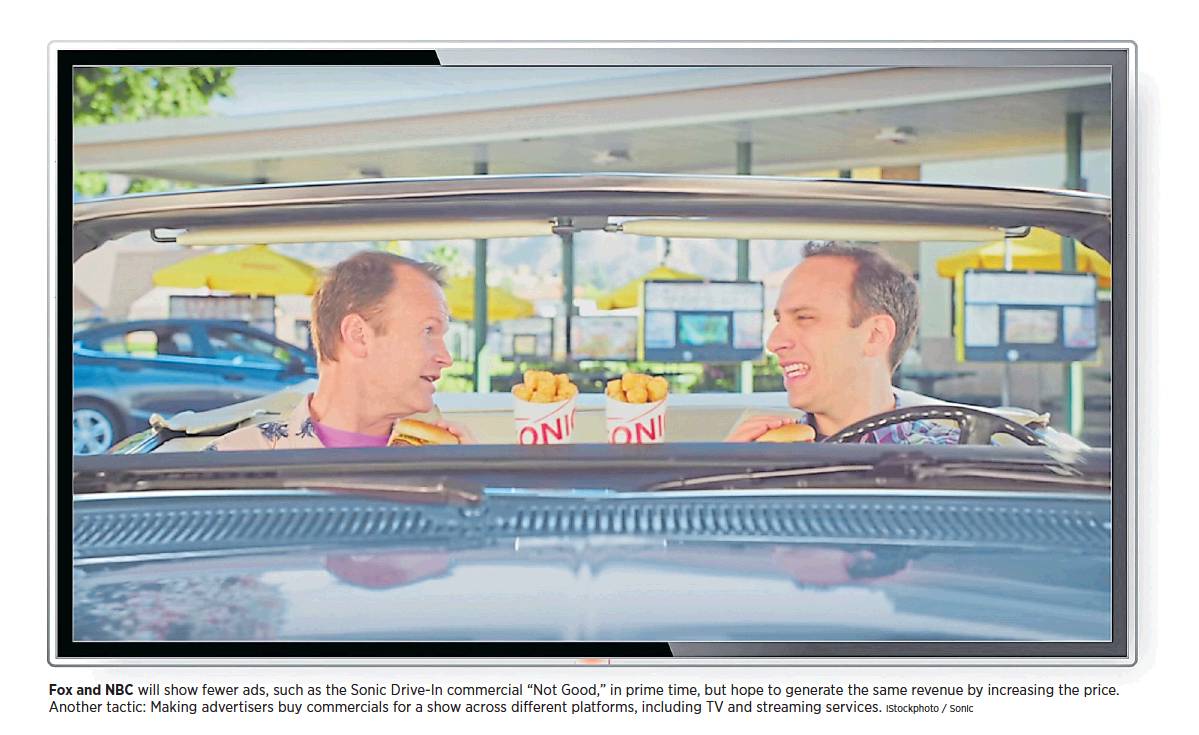By: Carter Wyckoff

To stop the bleed of viewers, network TV is looking to offer fewer advertiser spots. And charge more.
By Lucas Shaw and Gerry Smith BLOOMBERG NEWS
Comcast Corp.’s NBCUniversal and 21st Century Fox Inc. will reduce the number of ads they run in prime time, an effort to halt the stampede of viewers ditching live TV for the advertising-free environs of Netflix Inc.
The hope is that by curbing the supply of advertising, networks will be able to charge higher prices. The plans will be touted this week at the annual event known as the upfronts, when TV chieftains and Hollywood stars gather in New York to pitch advertisers on their upcoming slate of shows.
“We have to try something,” said Bruce Lefkowitz, Fox’s executive vice president of advertising sales.
Viewership of live TV is in free fall, which contributed to a decline in ad sales in 2017, according to data from research firm Magna Global. Making matters worse, the revenue is projected to keep falling for years to come.
The question is whether networks will follow through on their pledge to reduce ad time. They’ve been threatening to do so for years, but Lefkowitz says this time Fox is serious.
Fox is mounting its big experiment on Sunday nights, when it will reduce the number of commercials by 40 percent some weeks. The network will run just two national advertisements in each commercial break, which it’s calling a “jazz pod” (as in just A and Z). Every advertisement will immediately precede or follow a TV show.
Fox will announce some of the ways it plans to reduce the number of advertisements on Monday. Less commercial time will rob some shows of promotional slots, and will also force other shows to run longer.
Pod prices
Fox is charging as much as a 40 percent increase for the jazz pods, according to two people with knowledge of the matter who declined to be identified discussing ongoing negotiations. Fox declined to comment on the pricing, though it did say advertisers have expressed a lot of interest.
“We’ve gotten more incoming calls about our jazz pods than any product I can remember in my last 17 years,” Lefkowitz said. Fox will also benefit from the addition of “Thursday Night Football” to a schedule that is the least-watched among the four major broadcast networks.
Lefkowitz has worked at Fox long enough to remember when TV networks could rely on advertisers to spend more every year (save for the occasional recession). National TV advertising sales climbed from $4.2 billion in 1980 to $42.8 billion in 2016.
During that period, TV networks lost viewers to upstart online outlets such as YouTube and Hulu, but they were able to boost sales by charging higher rates.
Now, they’re no longer able to rely on that model because viewership has
fallen more quickly than prices have risen. By shrinking the supply — the amount of commercial time available — they hope to boost demand, which will enable them to charge higher prices.
Not ‘rosy’
The cost of a TV ad is expected to climb by 5 percent to 9 percent in the upfront marketplace, while advertisers are projecting a15 percent decline in ratings next season, according to David Cohen, president of North America at Magna Global.
“It’s not a very rosy picture,” Cohen said.
To make up for declining TV ratings, Time Warner Inc.’s Turner Broadcasting plans to require for the first time that advertisers buy commercials for a show across different platforms, including TV and streaming services. Doing so will boost Turner’s overall audience, creating a greater supply of advertising to sell, the network said. Turner has been in talks with a third-party company to verify those online viewers, just like Nielsen has done for years with television.
“Our success metric can’t just be Nielsen ratings on linear television,” said Donna Speciale, Turner’s head of advertising sales. “If you’re just buying linear TV, you are missing millions of viewers on video-on-demand and apps and online video. The clients and agencies have to open up their minds and not think of just television on the traditional platform.”
Sharing data
Turner is also one of the f o u n d i n g p a r t n e r s i n OpenAP, aconsortium of media companies that have agreed to share data so they can offer advertisers the chance to put their advertisements in front of specific demographic groups. TV has long sold ads based on more general demographics, such as gender and age groups (people between the age of 18 and 49, for example).
The internet has eclipsed TV as the top advertising medium in the U.S. by offering far more detailed profiles of its users’ likes, dislikes, and tendencies.
Owners of TV networks have tried to coax advertisers to their side by questioning the veracity and trustworthiness of metrics used by Facebook, Twitter, and Google’s YouTube, claims buttressed by a series of scandals. And yet advertisers are spending more online, forcing TV networks to try to replicate the models of the internet.